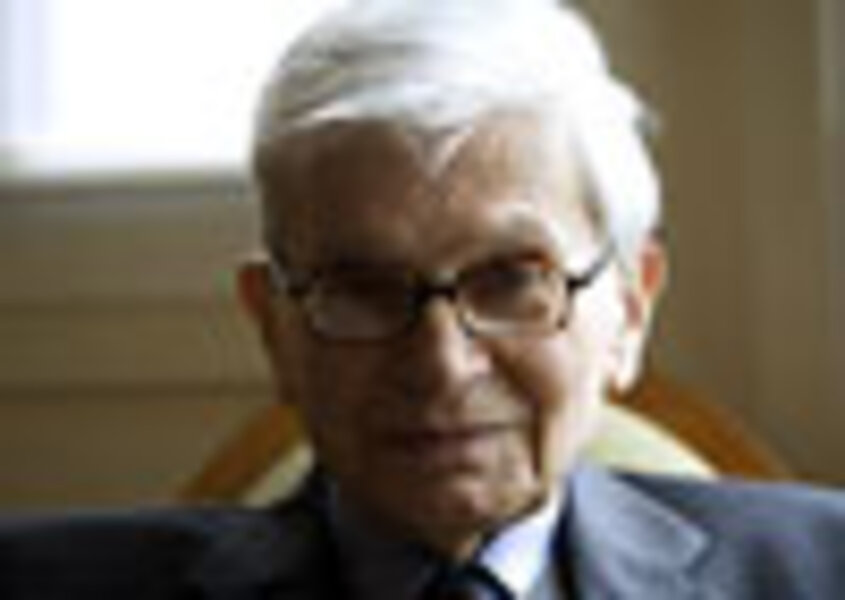Work on 'veiled reality' earns French physicist $1.4 million award
Loading...
For a young Frenchman, 1939 was a good time to think about alternative realities.
So it was that, on the eve of World War II, 17-year-old Bernard d'Espagnat first considered the idea that physical reality as it had been studied since the time of Sir Isaac Newton – consisting of measurable objects, light, gravity, and the like – may not be what it seems.
He would spend the next seven decades plumbing the philosophical implications of each new development in physics: What insights can science reveal about reality? About space? About time? He wrote 20 books, countless papers and articles, and is best known for positing that matter everywhere is entangled in a "veiled reality" that exists beneath time, space, and energy.
The University of Paris-Orsay theoretical physicist and philosopher of science is the 2009 winner of the Templeton Prize, an annual award of $1.4 million that "honors a living person who has made an exceptional contribution affirming life's spiritual dimension, whether through insight, discovery, or practical works." The Templeton Foundation announced the award Monday in Paris.
Including Dr. d'Espagnat, five of the past 10 Templeton winners have been physicists or have had strong connections to the discipline. Other recent winners include a Cambridge University mathematician and an applied math professor at the University of Cape Town in South Africa.
The field of quantum physics was just emerging when d'Espagnat first encountered it before the war. D'Espagnat's guide was Louis de Broglie's "Research on Quantum Theory." This winner of the 1929 Nobel Prize suggested that all matter has wavelike qualities, in addition to its more recognizable features, that have little or nothing to do with the human concepts of space and time.
D'Espagnat split the war years between study in Vichy France's "youth workshops" and forced labor at the hands of Nazis in Vienna. By war's end, he was studying at Paris's Ecole Polytechnique en route to a PhD from the Sorbonne. During an illustrious career in theoretical physics, he helped advance the theory that a new reality lurks behind matter and other observable phenomena.
Quantum physics is the study of systems at or below the atomic level: atoms, electrons, protons, and subatomic particles. With its subdiscipline, quantum mechanics, it exploded the basic tenets of classical physics. For d'Espagnat, quantum physics offered a subtler and perhaps humbler understanding of mankind's place in the universe than did conventional physics.
He is best known for probing what he calls "veiled reality": the realm beyond the ken of the visible and detectable, as it appears in glimpses through quantum mechanics.
D'Espagnat's contribution is most easily explained with reference to a series of famous experiments conducted in France and Switzerland in 1981-82 on the polarization of photons. A photon is a massless elementary particle with no electric charge. "Polarization" refers to the oscillation of the waves of the photon.
A team of physicists under the French physicist Alain Aspect found that a change in polarization of a photon miles from a separate photon could be detected in both – and it would all happen faster than the speed of light. This violated a series of principles on the behavior of particles.
For instance, it challenged a basic premise of classical physics: Nothing can travel faster than the speed of light. That, at least, would be true if "travel" is the operative word.
"Quantum mechanics introduced another point of view, which consists essentially that the aim of science is not to describe ultimate reality as it really is," d'Espagnat recounted by phone Friday from Paris. "Rather, it is to make account of reality as it appears to us, accounting for the limitations of our own mind and our own sensibilities.
"It's not that science will explain the ultimate reality of certain objects or events," d'Espagnat said. "Rather, it is that the concepts we use, such as space, time, causality, and so on, ... are not applicable to ultimate reality."
In recent decades, d'Espagnat took to popularizing his theories. In 1979, he published a widely circulated essay in Scientific American magazine challenging the doctrine of philosophical atomism, which held that objects in the world interact locally. This was two years before the Aspect experiments.
Last year, he published "Candide and the Physicist," a book for the lay reader answering 50 essential questions posed by the physician and philosopher Claude Saliceti on time, space, objects, and objectivity.
D'Espagnat, today a professor emeritus at the University of Paris-Orsay, has been a visiting professor in Germany, at the University of Texas at Austin, and at the University of California at Santa Barbara. He plans to split the money three ways after taxes: one-third for a research foundation, one-third for charitable causes, and the rest for his and his wife's health needs.





